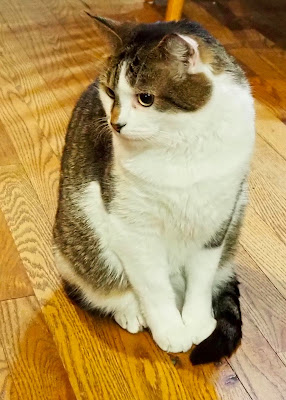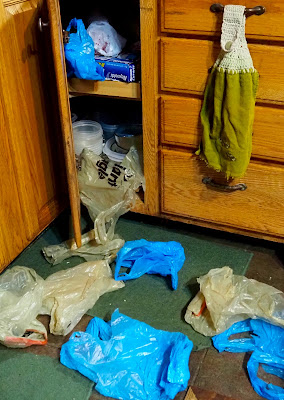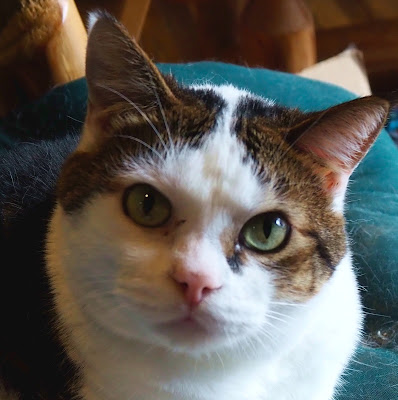Reflections - Endings and Beginnings
 |
Art and 1711 - Photo by Bruce
|
“I have bad news.” My brother-in-law’s serious telephone voice conveyed more than his words Wednesday, November 27.
Throat contracting, I feared Spence’s brother Bruce must have called about the death of his wife’s father. Though Art had been reasonably healthy, at age 105 . . .
Without the normal chuckle tingeing his voice, Bruce said, “Cindy’s father died Sunday. I’ve been calling Spence. The connection’s bad. I can’t reach him.”
“He’s at Titusville Ford. Spence wanted winter tires put on the Maverick before he drives to Cleveland through the snowbelt tomorrow. I’ll text and ask him to call you when he gets a stronger signal.”
Bruce didn’t offer a humorous anecdote nor use his joyous voice that rang as loud as a trolley bell. He muttered, “Thanks” and “I’ll email details.”


The next Wednesday, Spence and I drove to a reception for Art at Beinhauer Funeral Home south of Pittsburgh. With Art’s advanced age, I’d expected to find the family but not many others.
I was wrong.
Because Art had a passion for trolley, he was a founding member of the Arden Trolley Museum in Washington, Pennsylvania—later renamed the Pennsylvania Trolley Museum. He volunteered at the museum for seventy years and made numerous friends.
A steady stream of these folks paid their respects that bleak, breezy December afternoon. They grasped the hands of Art’s granddaughters and murmured “I’m so sorry, Laura,” or “My sympathy for your loss, Sarah.” Memories of Art’s enthusiasm for volunteering at the museum accompanied their sad smiles.
 |
Santa Trolley Group - 1999 Photo by Bruce
|
“Remember he used to take Polaroid photos of kids and Santa? Digital cameras and cell phones eliminated that job.”
 |
Art and 225 - 2003 Photo by Bruce
|
Wasn’t the number two-two-five he built special? Kids will clamber in his play trolley for years to come—even after they’re older than his designated age two to five.
 |
Art at the Controls on his 100th Celebration - Photo by Bruce
|
“Art never lost his touch. He operated the trolley on his hundredth birthday. He even operated car number seventy-eight for the Trolley Parade last summer. Imagine!”
What was absent from the funeral home were masses of flowers. Only two bouquets set near the coffin—a cheerful, colorful arrangement from the museum and a basket of red poinsettias from Art’s neighbors. People followed the family’s request and donated to the museum in lieu of flowers.
Art’s days at the museum ended. But Art’s enthusiasm had inspired his family and the members paying their respects. Because of Art, the donations and the people he influenced will support museum projects for years to come.


I’d attended the reception puzzled by a mystery.
A few hours after Bruce called about Art’s death, I sorted the mail and gasped. Art's meticulous printing—a small arc above the circle formed his lowercase “a”—wrote the Wells Wood address. His printed lines waved gently as if blown by a whispered breeze. With reverence, I eased open the flap to a Santa card. Art always sent Spence and me a Santa. I held the card in wonder. A treasured memory and a bit of a mystery. If Art sent it, how could the card be postmarked after he died?
I found Cindy, standing by her dad’s open coffin. We clutched in a long-lasting bear hug. “At least you had time to talk with him and share memories.” So lame. Though Art lived to 105, Cindy was still losing her father.
But she agreed. “Yeah. I’m glad I had the time with him.” So that Art could stay in his home, Artie, Cindy’s younger brother, had moved into Art’s house eight years earlier. Cindy spent a couple days a week with her dad—giving Artie and his wife Joanne time for other activities.
Before more mourners stepped in to express their condolences, I brought up the Santa card mystery.
She pressed her lips together and shook her head. “I knew he was in his room working away on something.”
Her brother Artie joined us.
I looked up at Cindy’s towering little brother. “I appreciated Art’s card. He always sent us a jovial Santa.”
Artie glanced toward the casket then back at us. “After he died, I found a stack of cards on his desk. They were stamped and ready for the mail. So I took them to the post office.”
Mystery solved.
At 4:00, the afternoon reception ended and the family needed a break. Spence and I followed their vehicles, like trolley cars in a train, to Arby's, a favorite of Art’s. He loved their gyros. Later our nephew Patrick and his daughters, Addy and Amelia, arrived. The girls had attended school that day.
Addy, almost ten, bustled in, black dress swaying below her winter coat. Her cheeks dimpled and she held her hands in yoga prayer position. “Aunt Janet, I loved the pictures you sent me. I’m going to try to send you some.”
Wow. My heart fluttered in delight. Which pictures? While she dashed off with her dad and sister to order food, I searched my memory. The last pictures I sent accompanied a postcard story of losing a journal at the Jane Austen conference. A humorous vignette, but the flowered journal and purple tote photos? Not exciting.
Independent-minded, science-oriented Addy probably referred to photos from the Buffalo Botanical Garden—tropical pitcher plants and a statue of a girl in a fountain. The girl’s arms flung wide and water sprayed her bare shins. The statue reminded me of Addy.
 |
Tropical Pitcher Plant
|
 |
Girl in the Fountain
|
Art wouldn't send me any more cards, but Addy might.
I hugged that hope as Spence drove home.


Halfway there on I 79, wind buffeted the Maverick. Wet snow made the dark road slippery.
Spence gripped the steering wheel.
I clutched the sides of the seat and pondered a Wells Wood memorial for Art. In the pitch dark, incoming snowflakes pinpointed the obvious choice. “Spence, let's plant our Christmas tree in memory of Art. I’ll decorate it with Santas.”
Spence steered the Maverick around a pokey pickup. “Sounds good. I’m going to Cleveland Thursday. I’ll buy a tree at Gale’s.”
We’d bought live Christmas trees from Gales for decades. Despite the mega snow, Spence crept to Willoughby Hills Thursday. But Gales hadn't ordered any b&b evergreens, trees with root balls wrapped in burlap, this year. Bummer.
The internet and I devised a new plan.
The following Sunday, the Maverick’s windshield wipers swiped rain. Spence drove me along thirty-five miles of winding country roads and into Hermitage’s six lane, stoplight controlled traffic to Kraynack’s. A football field size area of b&b evergreen trees spread before us. We separated and ambled through the trees. Drizzle dampened my stocking knit cap. Inhaling earthy and evergreen scents, I gawked at all the choices—various kinds of arborvitae, cedars, cypress, firs, hemlock, juniper, pines, spruces, and yews.
We met beside a white fir. Spence’s smile wrinkled his mustache. “What a beautiful tree. It’s taller than our usual trees.” He circled the evergreen. “I could manage with the tractor.”
At a four-foot blue spruce, a foot shorter than the white fir, Spence stroked his beard. “What a gorgeous color. And healthy. This would do.”
I fingered the needles—sharp as cat claws. The tree would scratch me when I decorated. Not my first choice.
Two aisles over, we viewed a white spruce, the shortest of the three. It sported the softest needles. “Look, Spence. Clusters of cones circle the top like a crown.”
He patted my shoulder. “Cute. None of our Christmas trees had cones before.”
The nurseryman tucked the white spruce diagonally in the Maverick’s short bed, and we drove home pleased with the start of a new tradition for buying Christmas trees.
Monday morning the familiar rumble of the tractor alerted me that Spence had loaded the white spruce. Thud. He slid the tree off the tractor bucket and into a wash tub. Thump-bump-thump. He rolled a dolly carrying the wash tub up the ramp.
Curious, our tabbies crept to the glass door and swiveled their heads following Spence’s movements.
On the other side of the glass door, he shoved wood under the tub to straighten the tree. Behind the cats, I waved my hands directing Spence. I stopped him with two thumbs up.
 |
| Chickadee Atop White Spruce |
Incoming chickadees and tufted titmice approved too. They landed on the spruce to queue for the bird feeder. Cats pounced against the glass by the birds. Our leaping tabbies didn’t scare the savvy birds.
I clomped upstairs and rummaged through the ornament box. A Santa-hatted snowman would look dandy on the tree’s leader. But Art’s tree needed more than one Santa. Why not make ornaments out of cards for the card sender? No worries—well Gilbert exhibited a few. He rubbed his whiskers against my arm and gazed at me with his should-I-call-911 look. I petted him and crafted—gluing Santas back to back, wrapping them in clear tape, and attaching white ribbons for hangers.
Bundled, I lugged the decorations box to the deck.
 |
Chickadee Approaching Feeder
|
Chickadees zoomed toward the bird feeder, about faced, and zoomed back. They called angry dee-dee-dees while I strung white lights and gold garlands around the spruce—three feet from the foot-high plastic chalet containing sunflower seeds. Nuthatches fluttered in, spotted me, and sped away.
I hung the eleven Santa card ornaments, and chickadees buzzed past my head. This leave message failed. I filled empty spaces with traditional sand dollar ornaments. So the chickadees zipped behind me, snatched seeds, and zipped out.
Art’s Santa tree fluttered with bird wings all day and cast light into long dark nights.


Over the coming weeks, the ornaments and snow didn’t halt perchers. Chickadees nestled in branches. A tufted titmice and chickadees even lit atop the leader’s Santa ornament. Birds sprang off. The hat’s pointed top and pom-pom swung as if waving goodbye.
The birds foretold the future. When planted, the white spruce will shelter birds and their young ones. The cute cones, that swayed our choice at Kraynak’s, will produce seeds for new trees.
Nature teaches—endings are beginnings.
 |
White Spruce Decorated
|
Acknowledgments
Rosamunde Pilcher, a modern Jane Austen, named one of her short stories “Endings and Beginnings.” Her title has intrigued me for decades. This year, I’d contemplated writing a story about the transition from the end of the old year to the beginning of the new year. When Art died, this story emerged.
Thanks to Bruce for providing Art’s photos and to Sarah for answering questions.
Thanks to Spence for accompanying me through the whole adventure, listening to various versions of the story, and encouraging me when I lost the story’s flow.
A very special thanks to Cindy. Over emails and during an extended phone call, she helped me with trolley terms and family facts. More than that, she cheered me on.
As for mistakes, they all belong to me.



























